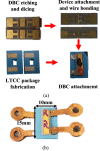Development of LTCC-packaged optocouplers as optical galvanic isolation for high-temperature applications
- PMID: 35804033
- PMCID: PMC9270388
- DOI: 10.1038/s41598-022-15631-7
Development of LTCC-packaged optocouplers as optical galvanic isolation for high-temperature applications
Abstract
This paper reports high-temperature optocouplers for signal galvanic isolation. Low temperature co-fired ceramic (LTCC) technology was used in the design and fabrication of the high-temperature optocoupler package. The optimal coupling behaviors, driving capabilities and response speed of the optocouplers were concentrated and investigated in this paper. Emitters and detectors with different emission and spectral wavelengths were studied to achieve optimal coupling behaviors. Relatively high coupling efficiency is achieved with emitters and detectors of emission and spectral wavelength in the red spectrum (i.e., 620-750 nm), leading to higher current transfer ratios (CTR). To further enhance the electrical performance, optocouplers with multiple detectors in parallel were designed and fabricated. CTR, leakage current and response speed (i.e., propagation delay, rise time and fall time) of the optocouplers were characterized over a range of temperatures from 25 to 250 °C. The CTR degrades at high temperatures, while the leakage current and response speed show little degradation with varying temperatures. Furthermore, the behaviors of the optocouplers with varying temperatures are modeled and analyzed.
© 2022. The Author(s).
Conflict of interest statement
The authors declare no competing interests.
Figures











References
-
- Kaminski, N. State of the art and the future of wide band-gap devices. In 13th European Conference on Power Electronics and Applications (2009).
-
- Kononchuk O, Nguyen B-Y. Silicon-on-Insulator (SOI) Technology: manufacture and Applications. Elsevier; 2014.
-
- Whitaker B, Barkley A, Cole Z, Passmore B, Martin D, McNutt TR, Lostetter AB, Lee JS, Shiozaki K. A high-density, high-efficiency, isolated on-board vehicle battery charger utilizing silicon carbide power devices. IEEE Trans. Power Electron. 2014 doi: 10.1109/TPEL.2013.2279950. - DOI
-
- Weng MH, Clark DT, Wright SN, Gordon DL, Duncan MA, Kirkham SJ, Idris MI, Chan HK, Young RAR, Ramsay EP, Wright NG, Horsfall AB. Recent advance in high manufacturing readiness level and high temperature CMOS mixed-signal integrated circuits on silicon carbide, semicond. Sci. Technol. 2017;32(5):054003.
-
- Barlow, M. et al. An integrated SiC CMOS gate driver. In Proc. Conf. IEEE Appl. Power Electron. Conf. Expo. (APEC) 1646–1649. 10.1109/APEC.2016.7468087 (2016).
Publication types
MeSH terms
LinkOut - more resources
Full Text Sources

